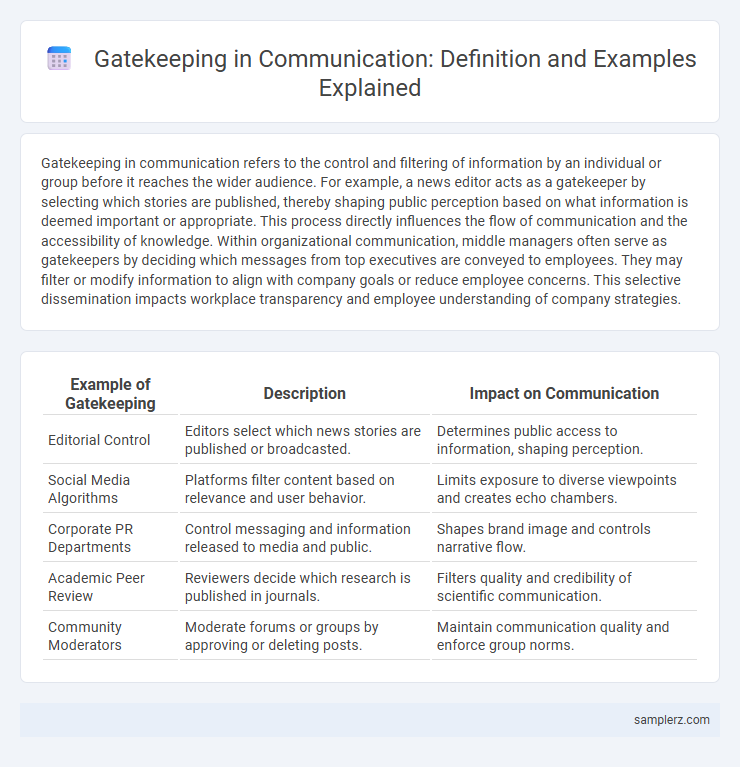Gatekeeping in communication refers to the control and filtering of information by an individual or group before it reaches the wider audience. For example, a news editor acts as a gatekeeper by selecting which stories are published, thereby shaping public perception based on what information is deemed important or appropriate. This process directly influences the flow of communication and the accessibility of knowledge. Within organizational communication, middle managers often serve as gatekeepers by deciding which messages from top executives are conveyed to employees. They may filter or modify information to align with company goals or reduce employee concerns. This selective dissemination impacts workplace transparency and employee understanding of company strategies.
Table of Comparison
| Example of Gatekeeping | Description | Impact on Communication |
|---|---|---|
| Editorial Control | Editors select which news stories are published or broadcasted. | Determines public access to information, shaping perception. |
| Social Media Algorithms | Platforms filter content based on relevance and user behavior. | Limits exposure to diverse viewpoints and creates echo chambers. |
| Corporate PR Departments | Control messaging and information released to media and public. | Shapes brand image and controls narrative flow. |
| Academic Peer Review | Reviewers decide which research is published in journals. | Filters quality and credibility of scientific communication. |
| Community Moderators | Moderate forums or groups by approving or deleting posts. | Maintain communication quality and enforce group norms. |
Understanding Gatekeeping in Communication
Gatekeeping in communication occurs when a person or group controls the flow of information, deciding what content reaches the audience. Editors in news organizations often act as gatekeepers by selecting which stories are published or broadcasted, shaping public perception. This process influences the accessibility and framing of information, highlighting the power dynamics in media communication.
Historical Examples of Gatekeeping
Historical examples of gatekeeping in communication include early newspapers, which controlled the flow of information by deciding which news stories were published and which were withheld from the public. Radio broadcasting in the 20th century also exemplified gatekeeping by limiting access to airwaves and filtering content based on regulatory and commercial priorities. These gatekeepers shaped public discourse by influencing which voices and perspectives reached mass audiences.
Gatekeeping in Mass Media Outlets
Gatekeeping in mass media outlets controls the flow of information by filtering news content through editorial decisions, shaping public perception and discourse. Editors and journalists act as gatekeepers by selecting which stories to publish, emphasize, or omit based on organizational policies, audience preferences, and political biases. This process influences societal knowledge and opinion formation by prioritizing certain narratives while excluding others.
Social Media Algorithms as Modern Gatekeepers
Social media algorithms act as modern gatekeepers by controlling the visibility and reach of content based on user behavior, engagement metrics, and platform policies. These algorithms prioritize certain posts, filtering information and shaping public discourse by deciding what users see in their feeds. This selective exposure influences communication dynamics, often creating echo chambers and affecting the diversity of viewpoints accessible to users.
Gatekeeping in Interpersonal Communication
Gatekeeping in interpersonal communication occurs when one individual controls the flow and access to information within a conversation, selectively sharing or withholding messages. This behavior influences relationship dynamics by shaping perceptions and managing the emotional responses of others involved. Examples include a manager who filters feedback to employees or a family member who regulates sensitive topics during discussions.
Organizational Gatekeeping Practices
Organizational gatekeeping practices regulate the flow of information by controlling which messages are disseminated within the company and to external audiences. Supervisors often act as gatekeepers by filtering employee communications, shaping internal newsletters, or approving press releases to ensure alignment with corporate policies and goals. This selective transmission helps maintain confidentiality, manage organizational image, and streamline communication processes.
Gatekeeping in Journalism and News Reporting
Gatekeeping in journalism controls which news stories reach the public by selecting and filtering information based on editorial policies and audience interests. Editors and journalists decide what content is published, influencing public perception and discourse through this selective process. This gatekeeping role shapes news narratives and can impact the diversity and balance of information available to society.
Cultural and Linguistic Gatekeepers
Cultural and linguistic gatekeepers control the flow of information by filtering messages based on cultural norms and language proficiency, often influencing the interpretation and acceptance of communication within diverse groups. These gatekeepers, such as translators, editors, or community leaders, play a critical role in shaping discourse by selecting which cultural references or linguistic expressions are conveyed or omitted. Their influence can impact cross-cultural understanding, either facilitating inclusion or perpetuating misunderstandings through biased or limited communication access.
Technological Gatekeeping in Digital Communication
Technological gatekeeping in digital communication occurs when algorithms prioritize certain content while filtering out others, significantly shaping the information users receive on platforms like social media and search engines. This form of gatekeeping influences public opinion by controlling visibility and accessibility of news, opinions, and social discourse. Companies like Facebook and Google utilize complex AI-driven filters, making them powerful gatekeepers in the digital communication landscape.
Impact of Gatekeeping on Information Accessibility
Gatekeeping in communication restricts the flow of information by controlling what content reaches the audience, often leading to selective exposure and information bias. This limitation impacts information accessibility by creating barriers for diverse viewpoints, thereby influencing public opinion and knowledge dissemination. In digital media, algorithms act as gatekeepers, filtering content based on user behavior, which can reinforce echo chambers and reduce information diversity.

example of gatekeeping in communication Infographic
 samplerz.com
samplerz.com